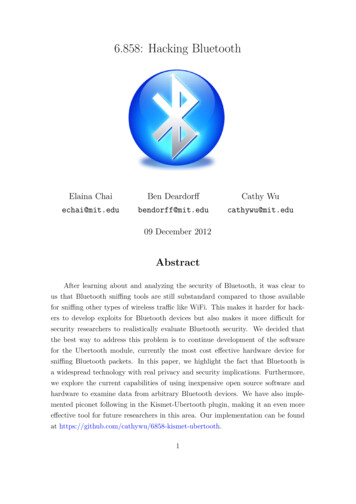
Transcription
6.858: Hacking BluetoothElaina ChaiBen DeardorffCathy Wuechai@mit.edubendorff@mit.educathywu@mit.edu09 December 2012AbstractAfter learning about and analyzing the security of Bluetooth, it was clear tous that Bluetooth sniffing tools are still substandard compared to those availablefor sniffing other types of wireless traffic like WiFi. This makes it harder for hackers to develop exploits for Bluetooth devices but also makes it more difficult forsecurity researchers to realistically evaluate Bluetooth security. We decided thatthe best way to address this problem is to continue development of the softwarefor the Ubertooth module, currently the most cost effective hardware device forsniffing Bluetooth packets. In this paper, we highlight the fact that Bluetooth isa widespread technology with real privacy and security implications. Furthermore,we explore the current capabilities of using inexpensive open source software andhardware to examine data from arbitrary Bluetooth devices. We have also implemented piconet following in the Kismet-Ubertooth plugin, making it an even moreeffective tool for future researchers in this area. Our implementation can be foundat https://github.com/cathywu/6858-kismet-ubertooth.1
Introduction12 of 28IntroductionBluetooth, since its inception in 1998, has become one of the most widely used short-range wireless protocols and has quietly become a part of our everyday lives. It is heraldedfor its convenience in connecting and exchanging information between devices such as cellphone headsets, mobile phones, telephones, laptops, personal computers, printers, GlobalPositioning System (GPS) receivers, digital cameras, video game consoles, and even faxes.Unfortunately, Bluetooth still contains a large number of security vulnerabilities despitethe claims made by the Bluetooth Special Interest Group.Despite known vulnerabilities, demonstrated hacks, and the decreasing cost of hacking Bluetooth, the number of Bluetooth devices manufactured today continues to grow.Currently, about 2 billion Bluetooth enabled devices are shipped each year, with mobilephones make up the bulk of Bluetooth shipment numbers.In this paper we highlight the fact that Bluetooth is a widespread technology with realprivacy and security implications. Furthermore, we explore the current capabilities of usinginexpensive open source software and hardware to examine data from arbitrary Bluetoothdevices. We have also implemented piconet following in the Kismet-Ubertooth plugin,making it an even more effective tool for future researchers in this area. Our implementationcan be found at n Section 2, we introduce the Bluetooth protocol. In Section 3, we discuss Bluetoothsecurity, including the security model, weaknesses, barriers to hacking, and existing hardware sniffing tools. In Section 4 and 5, we discuss the tools we used and our implementation.Finally, we discuss future work in Section 6, and we conclude in Section 7.22.1Bluetooth protocolPairingOriginally designed to be a humble cable replacement technology, Bluetooth is now awireless technology standard for exchanging data over short distances. Slave devices (e.g.6.858: Hacking Bluetooth
Bluetooth protocol3 of 28Figure 1: Pairing process.headset, keyboard) connect with master devices (e.g. phone, laptop) by a pairing process asshown in Figure 1, in which device IDs are passed and a number of keys are generated. Thepairing process usually involves some level of user interaction (e.g. entering a PIN), whichis the basis for confirming the identity of the devices. Because of the user interaction, thePIN is not transmitted over the wireless channel. An initialization key is then generatedfrom the PIN. The initialization key is used to agree upon a link key, which depends onthe type of communication desired. The link key is then used to generate the encryptionkey.6.858: Hacking Bluetooth
Bluetooth protocol2.24 of 28Frequency hoppingBluetooth is more complicated than most wireless standards in that it does not stay onany particular channel for long. In fact, 1600 times per second, Bluetooth hops between 791-MHz channels using a spread spectrum frequency hopping radio. A master can connect upto 7 slave devices simultaneously; paired slave devices and the master device form a piconet,wherein all the devices share a clock for synchronized communication. The devices in thepiconet all use the master’s information to stay in sync; the master’s device ID determinesthe hopping pattern, and the master’s clock determines the phase in hopping pattern [9].Each device ID maps to a unique hopping pattern.Although spread-spectrum signals are more difficult to intercept, frequency hoppingis not designed to be a security mechanism. Rather, frequency-hopping spread spectrum(FHSS) is highly resistant to narrowband interference, which is where Bluetooth operates[23]. To further reduce interference from wireless LAN (Wi-Fi), which operates in the sameradio band, Bluetooth also implements Adaptive Frequency Hopping (AFH). Devices operating with AFH identify ”bad” channels that may cause interference and avoid them. These”bad” channels are those that are presently occupied by a WLAN transmission. WLANdevices typically do not change channels, but WLAN channels span multiple Bluetoothchannels [14]. These frequency hopping schemes are an inconvenience rather than a barrierfor Bluetooth hackers.2.3Device IDThe Bluetooth device ID (or Bluetooth Address BD ADDR) is a unique 48-bit numberused to identify each Bluetooth device, similar to Ethernet’s MAC address for a computer.Unlike the MAC address, however, which is foregone for IP addresses at the higher layers ofcommunication, the BD ADDR is used throughout the Bluetooth protocol – for low-levelradio protocols, identity, authenication, and synchronization. Within a piconet, all devicesincluding slaves transmit using the master’s device ID.The BD ADDR (Figure 2) consists of a 2-byte Non-significant Address Portion (NAP),a 1-byte Upper Address Portion (UAP), and a 3-byte Lower Address Portion (LAP). Asthe name suggests, the NAP is not used in any critical aspects of the Bluetooth protocol,6.858: Hacking Bluetooth
Bluetooth protocol5 of 28Figure 2: Bluetooth address.except in encrypting packets. Since the BD ADDR is so widely used, it is essential thatdevices maintain its privacy by keeping its BD ADDR secret. Unfortunately, device IDsare publically available via Bluetooth inquiries for devices in Discoverable Mode. Evenwhen not discoverable, all Bluetooth packets are sent with the LAP of the device (or ofthe master if part of a piconet) in cleartext. There are also straightforward methods fordetermining a device’s UAP, by either timing the gaps between packets or extracting acyclic redundancy check (CRC) code from a packet payload). Knowing the LAP and UAPof a device allows for passive monitoring and attacks.2.4Forward error correction (FEC)Forward error correction (FEC) is a technique used for controlling errors in data trans-mission over unreliable or noisy communication channels. FEC uses an error-correctingcode (ECC) to encode messages in a redundant way. The purpose of FEC is to reduce thenumber of retransmissions, not to provide security. A CRC (cyclic redundancy check) codeis added to each packet and used by the receiver to decide whether or not the packet hasarrived error free [1].2.5Data whiteningBefore transmission, both the header and the payload of each packet are scrambledwith a data whitening word in order to randomise the data from highly redundant patternsand to minimize DC bias in the packet. Whitening is a feature for signal transmission, not6.858: Hacking Bluetooth
Bluetooth security6 of 28security. The scrambling is performed prior to the FEC encoding [2].3Bluetooth security3.1Bluetooth security model3.1.1Security goalsThree basic security services defined by the Bluetooth specification [20]: Authentication A goal of Bluetooth is the identity verification of communicatingdevices based on their Bluetooth device IDs. This service provides an abort mechanism if a device cannot authenticate properly. Bluetooth does not provide nativeuser authentication. Confidentiality Another goal of Blueooth is to maintain the privacy of users anddevices. The intent is to prevent information compromise caused by eavesdroppingby ensuring that only authorized devices can access and view transmitted data. Authorization A third goal of Bluetooth is a security service developed to allow thecontrol of resources, which ensures that a device is authorized to use a service beforepermitting it to do so.3.1.2Security mechanismsBluetooth implements its security goals by: Authorization (user inputs PIN) In a short range wireless network, there canbe no centralized, trusted party. Bluetooth offloads the question of authorizing communication between devices to the user. The user initializes the access betweentwo devices by identifying and selecting the appropriate device by device name (e.g.”Cathy’s Macbook Pro”, ”Keyboard01”), which maps directly to a device ID. Theuser is next prompted to enter a PIN that displays on one device into the other deviceor is instructed to follow special button presses.6.858: Hacking Bluetooth
Bluetooth security7 of 28 Authentication (verify link key) During the initalization stage, the two devicesalso agree upon a secret link key, derived from the PIN, and it is stored between sessions. The authentication procedure (Figure 3), then, gives one device an opportunityto verify its knowledge of the secret key, and thus its identity [3].The Bluetooth authentication procedure is in the form of a ”challenge-response”scheme. The two devices interacting in an authentication procedure are referred toas the claimant and the verifier. The verifier is the Bluetooth device validating theidentity of another device. The claimant is the device attempting to prove its identity.One of the Bluetooth devices (the claimant) attempts to reach and connect to theother (the verifier). The steps in the authentication process are the following:1. The claimant transmits its 48-bit address (BD ADDR) to the verifier.2. The verifier transmits a 128-bit random challenge (RAND) to the claimant.3. The verifier uses the cryptographic E1 algorithm (Bluetooth standard) to compute an authentication response using the address, link key, and random challenge as inputs. The claimant performs the same computation.4. The claimant returns the computed 32-bit signed response (SRES), to the verifier.5. The verifier compares the SRES from the claimant with the SRES that it computes.6. If the two SRES values are equal, the verifier will continue connection establishment. Confidentiality (stream cipher encryption) Bluetooth can encrypt the packetpayload (Figure 4), using a stream cipher called E0. The cipher is stored temporarilyand re-synchronizes for every payload, whereby minimizing the effectiveness of correlation attacks. As input, the E0 algorithm uses the master Bluetooth address, themaster real-time clock and the encryption key. The encryption key is derived from thecurrent link key, ciphering offset and a random number. Most Bluetooth encryptionschemes use a encryption key between and 1 and 16 bytes long. The master sendsthe random number in plain text to the other devices before encryption is started.6.858: Hacking Bluetooth
Bluetooth security8 of 28Figure 3: Authentication via verifying the link key [3].The E0 algorithm delivers a key stream which is XOR-ed to the data that shall beencrypted. Since the cipher is symmetric, decryption is handled in the same way.Modern Bluetooth devices implement all three security services, but in order to providebackwards compatibility and for performance considerations, each of these services are notenforced. Different levels of security are more appropriate for different applications. Forexample, pacemakers operating via Bluetooth should enforce more security features thana stereo that is streaming music via Bluetooth. However, these security controls are notalways used appropriately.3.2Security assumptionsBluetooth makes several assumptions about its security. It assumes that once a con-nection established, the connection between devices will be permanently secure. It alsoassumes that short range provides high security (an attacker is not nearby); the Bluetoothrange is typically 5-30m from the device. Additionally, Bluetooth authenticates per device,assuming that all services and users on a particular device should follow the same securitypolicy.6.858: Hacking Bluetooth
Bluetooth security9 of 28Figure 4: Confidentiality via stream cipher encryption [3].3.3Known Vulnerabilities and AttacksThe weakest part of the Bluetooth protocol is during the initial stages to set up theconnection, before encryption is fully utilized. Because of this, a great deal of the focusof past Bluetooth attacks have been on taking advantage of the vulnerabilities in theseinitial stages. This is in no small part due to the weak/lack of encryption used to securethe pairing process, the lack of hopping during these stages, and the use of DiscoverableMode.3.3.1Active Device Discovery: Inquiry ScanningBecause of the lack of a central server, Bluetooth devices need some other way todiscover each other existence without interfering with other devices. Such as meachanismis described in the Bluetooth Specification as ’inquiry scanning’. When a master device,such a laptop, is trying to find other devices in the area to connect to, it will broadcastinquiry scan messages over multiple frequencies. Bluetooth slave devices, when they are ina special mode called ’discoverable mode’, will respond with a inquiry response message.This message will contain information necessary to initiate the pairing, which is in this caseis the Bluetooth address of the slave, and its device clock.6.858: Hacking Bluetooth
Bluetooth security10 of 28Inquiry Scanning is a very vulnerable stage of the specification. The response messagesare sent over a wide range of frequencies and in plaintext, so an attacker would need toknow neither the keys nor the piconet attributes to capture the packet and discover theBD ADDR and the device clock. If a device does not enforce encryption, then attacker canpotentially flood all the channels with packets with an approriate header to inject packetsinto the victim device.The information sent in this response message is all that is needed to construct apiconet and de-whiten the packets. Even if the information is encrypted, the LAP is sentin plain text, so the Bluetooth packets can still be captured and decrypted later.3.3.2Traditional Pairing ProcessThe Pairing process described above also contains known and well-explored vulnerabilties. Recall that the Pairing process employs two keys: Link Key: requires the PIN (usually 4 digits) Encryption Key: requires the Link Key, ciphering offset and a random numberThe security of the Link Key rests on the PIN being secret. This assumption that thePIN is secret is incredibly broken because even in the case the PIN is not the standard’0000’ or ’1234’, most PIN’s are only 4 digits. That results in 104 possible PIN combinations to choose from, making brute-force attacks very easy. From there, the data requiredto generate the encryption key can be easily acquired, breaking the Confidentiality mechanism.A very well-understood and common Bluetooth attack takes advantage of the vulnerabilities in Discovery and Pairing processes. This attack focuses on forcing the devices todisconnect by flooding the channels with packets indicating the slave has lost the key. Thisforces the devices to redo the Pairing process, which the attacker can then observe andobtain the link and encryption keys.The ’Tradtional Pairing Process’ has since been succeeded in the Bluetooth Specification v2.1 by a more secure protocol called Secure Simple Pairing. This protocol employsPublic Key Encryption instead of the PIN to generate the link key. Nevertheless the vul6.858: Hacking Bluetooth
Bluetooth security11 of 28nerability described is still a cause for concern because many devices support the protocolsdescribed in the older Bluetooth Specifications for backwards compatability.3.3.3Known AttacksThese vulnerbilities allow a range of attacks to be easily carried out. Packet sniffingis a major attack and of primary concern because of the sensitivity of the data that ispotentially passed via Bluetooth. Vulnerable Bluetooth keyboards could reveal sensitiveinformation such as passwords and credit card information. Another major attack is packetinjection. Knowing the piconet and the BD ADDR of the victim device goes a long way inallowing an attacker to properly craft packets that will be captured and read by the victimdevice.Bluetooth is vulnerable to Man-in-the-middle attacks. In a 2010 paper by Haataja andToivanen, called ’Two Practical Man-In-The-Middle Attacks on Bluetooth Secure SimplePairing and Countermeasures’, the writers were able to carry out an attack in which theyjam all frequencies in order to trick the devices to assume that they have been disconnected.The devices reinitiate the discovery and pairing process. During this phase, the writerssuccessfully use two Bluetooth modules to pose as the master and slave devices, therebymaking packet injection and packet authentication attacks possible. Such asn attack is notprotected by SSP either, becausethe weakness is not in the encryption mechanism, but inhow devices handle disconnections and reconnections. The victim devices are in realityconnecting to the attacking devices instead of to each other directly.Another known attack is Car Whisperer, a project by the Trifinite group that soughtto expose the effect of the vulnerabilities described above. The purpose of the projectwas to make car manufacturers aware of the inherent vulnerabilities in the Bluetooth setsinside cars. This group discovered that not only were Bluetooth sets left in Discoverablemode, but the Pairing Process was also vulnerable because the passkey, which was usedin these Bluetoot sets in the place of PIN’s, were left at their default values set by themanufacturers. While standing on a bridge over a highway, the researchers were able touse high-powered Bluetooth modules to connect to the Bluetooth modules in cars passingbeneath them. Once a connection was established, the researchers were able to inject audiointo the car’s speakers. They noted that attackers could also potentially eavesdrop on the6.858: Hacking Bluetooth
Bluetooth security12 of 28car passengers.Wireless modules are very draining on their hosts. For this reason, manufacturers liketo include some sort of ’sleep’ mode in their devices when it is not actively transmittingpackets. In 2008, a group at the University of Utah demonstrated in the paper ”BatteryDraining-Denial-of-Service Attack on Bluetooth Devices”, an attack where they repeatedlybombarded a Bluetooth device with malicious requests. This attack not only rendered thedevice unusable, but heavily drained the battery resources. The only way to defend againstsuch an attack would be to operate the device in so-called ’silent’ mode, where the deviceonly listens to the network but under no circumstances responds to any requests. Evenoperation under ’non-discoverable’ mode, would not stop the determined attacker, becausethe attacker just need to attach the appropriate header (which can be gained via passivelistening) to the request mesasges for the victim device to accept the packet.3.4Potential WeaknessesThere are other parts of the Bluetooth specification that are intended to reduce in-terference with other devices, and increase security. However they contain their set ofweaknesses, some of which are described below:3.4.1Non-Discoverable ModeTo mitigate the attacks described above, Bluetooth devices now usually feature a modecalled ’Non-Discoverable’ Mode, which default to. This simply means that the device willnot attempt to respond to inquiry request messages it sees. Devices will only enter Discoverable mode when a special button is pressed on the device itself. After a timeout thatusually last for a few seconds, the device will change back to Non-discoverable mode.This does not mean the device is safe. As long as the Bluetooth device is powered onit still will accept packets being sent to it with the approprorpriately constructed header(which just contains an error correcting code, a sequence to correlate data, and mostimportantly, the LAP of the receiving device). This means that this device is still not safefrom attacks such as packet injection, as long as the attacker knows the correct LAP for6.858: Hacking Bluetooth
Bluetooth security13 of 28the device.3.4.2Globally Unique BD ADDRThe BD ADDR, like the MAC address in your computer, is supposed to be globallyunique. This is particularly important in the Bluetooth protocol because it is used bythe Bluetooth devices to filter packets not intended for it. However, in 2005, researchersat CSAIL found that this was not really the case. This is potentially a huge securityvulnerbility. An attacker could assemble a list of commonly used BD ADDR’s use a devicesuch as spooftooph, which allows the attacker to change the BD ADDR of his computer’sBluetooth module. He could iterate through a list of commonly used BD ADDR’s untilhe starts finding packets. Now knowing the BD ADDR of a device nearby, he can thenproceed to launch attacks such as packet sniffing and packet injection.3.5What’s Tricky?Unlike the 802.11 wireless module in most laptops, standard BROADCOM Bluetoothmodules do not support passive packet sniffing. Recall that any packets being sent to themaster device will contain the master’s LAP in its header. The master device uses thisinformation to filter out any packets not intended for it before sending it to the CPU. Thisfiltering is carried out on a very low level of the Bluetooth protocol stack.This makes sniffing Bluetooth very tricky. To sniff any packet sent over a wirelessnetwork, your receiver needs to be able to operate in so-called ’promiscuous’ mode. In thismode, the receiver receives all the packets it can read without any regard of who it wasintended for, and sends it to the CPU. However, implementing ’promiscuous’ mode insideBluetooth, is both unnecessary and expensive from the viewpoint of the manufacturer.Therefore the firmware and the hardware for general-purpose bluetooth modules simplydo not support this mode. In the rare case that the hardware can support promiscuousmode, the firmware is usually closed-source. Making the necessary changes to the firmwarecode to implement ’promiscuous’ mode would require extensive reverse engineering of thefirmware itself.6.858: Hacking Bluetooth
Bluetooth security3.614 of 28Existing hardware solutions for sniffing BluetoothBecause standard Bluetooth modules make it incredibly difficult to implement anysort of packet sniffing, you would have to turn to more specialized hardware to do this.Not supporting promiscuous mode is not only a hinderance to security researchers. It isalso a hinderance to developers trying to develop Bluetooth related hardware themselves, asdebugging is near impossible without some sort of sniffing feature or access to the lower levelinformation contained in the Bluetooth packet. Fortunately, this is enough of a problemthat a market for hardware solutions exists for doing just this exists:3.6.1FTS4BTAn example of a commercial platform for analyzing this lower-level information in realtime is the FTS4BT[7]. It is a hardware and software package created for sniffing anddebugging Bluetooth devices. It is an incredibly powerful platform, and the hardware is isspecially developed Bluetooth transceiver. Its big brother, the BPA 500, is about the sizeof a traditional wi-fi router and claims it can support all adopted specifications, profiles andprotocols.The FTS4BT would the be the ideal solution to start sniffing packets if it wasn’t forthe price. Unfortunately the market for these sort of hardware solutions is still a nichemarket (though this may change as Bluetooth becomes even more popular), so commercialsolutions like the FTS4BT tend to be incredibly expensive, starting at a price point of 10,000. This price keeps it firmly inaccessible to many hobbyist researchers.3.6.2USRPA cheaper alternative to the FTS4BT was found. It was the Universal Software RadioPeripheral [6], a hardware platform, which when used with the GNU Radio Project[8],allowed for the user to implement radio projects very easily in software. It has the advantage of having a very large bandwidth, allowed the user to listen to multiple channelssimultaneously. Bluetooth security researchers Michael Ossmann and Dominic Spill, consequently developed gr-bluetooth, a collection of tools to do things such as packet sniffing6.858: Hacking Bluetooth
Bluetooth security15 of 28and following the piconet.While the USRP is a significant step in the right direction for improving the affordability of hardware solutions for sniffing Bluetooth, at 1000, it is still out of the price pointfor many hobbyist security researchers. This resulted in a relatively limited community ofBluetooth hackers and consequently, few projects investigating BLuetooth security. Thismeant the Bluetooth security is actually in a state of ’security by obscurity’. Just becauseyou are not hearing about Bluetooth vulnerabilties all the time does not mean the vulnerbilities do not exist. Joshua Wright, a prominent Bluetooth Security Researcher andco-author of the ’Hacking Wireless Exposed’ Series likes to state the following (and thusconsequently dubbed by his follwers as Wright’s Law)“Security will not get better until tools for practical exploration of the attack surfaceare made available.” -Joshua Wright [28]3.6.3Ubertooth OneMichael Ossmann sought to address the problem of the lack of affordable hardwaresolutions. He saw no reason why tools such as the FTS4BT should be so expensive, thoughhe speculated it might just be due to a lack of competition. He decided to create his ownBluetooth module with three key features: Hardware Support for Passive Packet listening Open Source Firmware and Software Cheap: Price of at most 100He succeeded, and in 2010 announced his project ”Project Ubertooth”. The first versionof the hardware was dubbed ’Ubertooth Zero’.[21]Since then, he has released a more powerful Class 1 version of the hardware called”Ubertooth One”. While the hardware was released in 2011[25], the firmware and hostcode still had to be fully developed, but now researchers had a hardware platform theyeasily access and subsequently build upon. The code for the Ubertooth is still in an veryactive and relatively premature stage of development, and so cannot be called a complete6.858: Hacking Bluetooth
Exploration of tools16 of 28Figure 5: Ubertooth One Module [31]Bluetooth sniffing solution yet. A goal of our project was to identify and thus develop codefor incomplete areas of this Open Source project.4Exploration of toolsIn order to examine the current state of Bluetooth security we learned about and em-ployed quite a few different tools, including a three Ubertooth modules, numerous bluetoothdevices, and various Open Source software tools for sniffing Bluetooth traffic or exploitingBluetooth devices. Our study and use of these tools made it clear that more developmentneeded to be done in order to make them good enough for effective Bluetooth vulnerabilitytesting.6.858: Hacking Bluetooth
Exploration of tools4.117 of 28HardwareOnce we settled on using the Ubertooth, we had to see what the current hardware,firmware, and software developed for it were capable of. Installing the tools that werealready developed by the Project Ubertooth team we were able to do the following: Passively detect Bluetooth devices, even when they were not in discoverable mode Detect the Upper Address Part (UAP) of Bluetooth devices (only the LAP is typicallysent in communications) Use the Ubertooth software to follow a single Bluetooth device as it hopped acrosschannels Passively capture Bluetooth traffic on one channel with a Kismet plugin and displaycaptured packets in WiresharkThese features allowed us to learn a lot more about how our Bluetooth devices werecommunicating and were helpful for general Bluetooth device detection and traffic analysis,but they were not quite sufficient to allow us to really test the possible vulnerabilities in theBluetooth scheme. We were still unable to capture Bluetooth traffic accross all channelsand display it in an easy to analyze format, force a connection with another Bluetoothdevice, nor inject malicious packets. The next step we took was to test various softwarepackages that might be used in conjunction with the Ubertooth to develop sufficient sniffingor exploit tools.4.2SoftwareWe experimented with a number of software tools when analyzing Bluetooth security,including, but not limited to the following:4.2.1Ubertooth Host CodeThe Ubertooth host code written by the Project Ubertooth team for the Ubertoothmodule consists of three primary tools: a wireless spectrum analyzer, ubertooth-follow6.858: Hacking Bluetooth
Exploration of tools18 of 28(code for following a specific Bluetooth device and printing captured packets to the command line), and a Kismet-Ubertooth plugin that captures Bluetooth traffic across onechannel and formats and dumps it into a file for further anaylsis in Wireshark [25].4.2.2KismetKismet is a wireless network detector and sniffer, which is most commonly used forsniffing 802.11 wireless traffic [17]. However, we mainly used it in conjunction with theKismet-Ubertooth plugin to detect Bluetooth traffic. One of the best features of Kismet isthat it can save all packets captured in a .pcapbtbb file which can be o
6.858: Hacking Bluetooth Elaina Chai echai@mit.edu Ben Deardorff bendorff@mit.edu Cathy Wu cathywu@mit.edu 09 December 2012 Abstract After learning about and analyzing the security of Bluetooth, it was clear to us that Bluetooth sniffing tools are still substandard compared to those available for sniffing other types of wireless traffic like WiFi.










